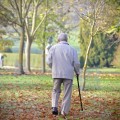
As adults age, they may lose muscle strength and balance. This increases their risk for falling and sustaining an injury. New research uses virtual reality to study which muscles are responsible for maintaining balance – which holds promise for care providers working with seniors.
"We also learned how individual muscles are highly coordinated in preserving walking balance. These things provide an important roadmap for detecting balance impairments and the risk of future falls," noted Jason Franz, who led the study from the University of North Carolina, Chapel Hill.
Delving further into VR
Franz and his team found that younger people typically rely on neurological messages sent from the legs and feet to help them maintain balance. As individuals age, they may begin to rely more on visual cues. To test this, they used virtual reality to simulate a hallway. Participants walked on a treadmill, while electrodes recorded neurological signals and muscle movements.
"Older participants rely more on visual cues."
Franz would change the image on the screen to make participants feel as if they were wobbling side to side. What he found was the older participants, who rely more on these visual cues, may be more likely to suffer from a fall as a result.
The future of falling
However, falling should not be an expected part of growing old. In addition, the fear of falling can have unintended consequences for seniors. According to Deseret News, many seniors are chronically dehydrated because they are afraid that they will have difficulty getting up to use the bathroom in the middle of the night.
According to Dr. Peter Abadir, "Some patients won't even take their diuretic medications during the nighttime because it makes them get up during the night and disturbs their sleep. Similarly, they won't drink later in the day because they don't want to get up during the night when it may be more difficult to ask for help."
One day of dehydration may not be enough to cause a fall, the publication noted. However, when that dehydration builds up over several weeks, seniors may not realize it until they stumble. Other symptoms can include dizziness, which can mimic the visual shifts researchers created with VR.
How can care givers help? They can aim to give seniors four ounces of water every hour they're awake. While every patient's needs are different, researchers found that men should be drinking 120 fluid ounces on average, while women should aim for 91 ounces. Additionally, they can set a schedule as a reminder to drink water throughout the day.
To learn more about how you can help seniors avoid falling, consider enrolling on "Fall Management: A Guide for Health Care Providers" today. Click here to learn more.


